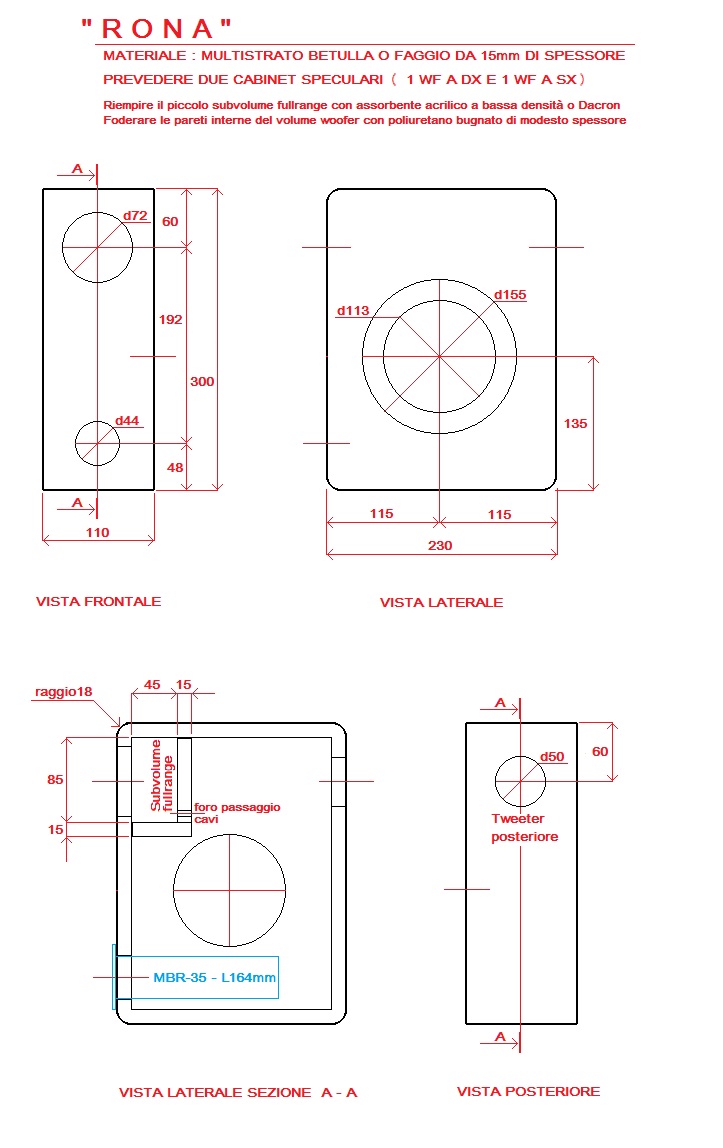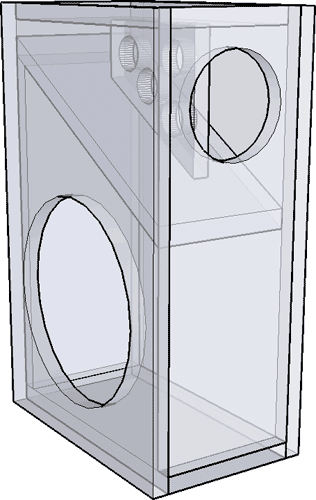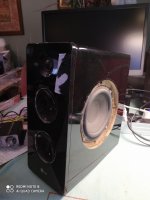correction for post # 41
"Bass 2.5mH Coil, 2.2 ufd Cap to Tang band W5-1138smf 2nd order"
should be 22 ufd cap on the woofer.
No, in the W5 the Woofer has no filter. It is running free and this also functions very well here. The W5 does not use any 2nd order filters in its original version (also the SE does not). All filters used there are 1st order.
Sorry, nevermind, it was the other speaker you were writing about...
found this on theebay
Auris Poison 1 speakers Black, SEALED ! | eBay
check the crossover, it says, " COF P1 _ P3 "
? Crossover of Poison 1 _ Poison 3 ?
same crossover as the Auris Poison 3
Auris Audio Poison 3 – HiFi Knights
Another crossover option from the Auris-commercial clone of the Boenicke W5- same drivers , different cabinet.
Auris Poison 1 speakers Black, SEALED ! | eBay
check the crossover, it says, " COF P1 _ P3 "
? Crossover of Poison 1 _ Poison 3 ?
same crossover as the Auris Poison 3
Auris Audio Poison 3 – HiFi Knights
Another crossover option from the Auris-commercial clone of the Boenicke W5- same drivers , different cabinet.
Last edited:
Auris may use the Peerless 830945 woofer?
>Here's a similar style speaker about 1/4 way down, frequncy response looks better than the Boenicke W5 - Rona
Scelta ragionata di un altoparlante e suo eventuale impiego per la costruzione di un utopia micro - Pagina 6
Google Translate
>Here's a similar style speaker about 1/4 way down, frequncy response looks better than the Boenicke W5 - Rona
Scelta ragionata di un altoparlante e suo eventuale impiego per la costruzione di un utopia micro - Pagina 6
Google Translate
Last edited:
>Here's a similar style speaker about 1/4 way down, frequncy response looks better than the Boenicke W5 - Rona]

Encouraging to see all the development work i did on Tysen (ealy 2009) and Tysen V2 years ago. This was posted May 2009

Unfortunately the SDX7 woofer is NLA (but could come back — i really miss it).
But as i have said before, there are many, many ways to do this. The important part is the releif of the small FR from having to do bass, thus improving their performance in the bandwidth used..
dave
Hello.
I have build a pair of W5 SE clones and want to share some info and ideas.








I have taken measurements from the drivers because I couldn’t see any trustable crossover over the web. After that, I have simulated all the crossovers available and I think none of them are the best choice. At least with my measurements (calibrated mic and Arta software).
First, my measurements say that rear tweeter has minimum influence in the system because the rear position makes it being like 15dB les than fullrange driver Fountek FE85.
Second, you don’t have to worry for the TB W5-1138SMF Subwoofer from 1KHz as it won’t be heard.
Third the FE85 in my cabinet has a big dip between 5KHz and 11KHz much bigger than the one in the Fountek specs.

The same dip problem can be seen in this measurements:

They have been taken from this thread:
http://techtalk.parts-express.com/forum/tech-talk-forum/54391-fountek-fe85-measurements
I have build a pair of W5 SE clones and want to share some info and ideas.








I have taken measurements from the drivers because I couldn’t see any trustable crossover over the web. After that, I have simulated all the crossovers available and I think none of them are the best choice. At least with my measurements (calibrated mic and Arta software).
First, my measurements say that rear tweeter has minimum influence in the system because the rear position makes it being like 15dB les than fullrange driver Fountek FE85.
Second, you don’t have to worry for the TB W5-1138SMF Subwoofer from 1KHz as it won’t be heard.
Third the FE85 in my cabinet has a big dip between 5KHz and 11KHz much bigger than the one in the Fountek specs.

The same dip problem can be seen in this measurements:
They have been taken from this thread:
http://techtalk.parts-express.com/forum/tech-talk-forum/54391-fountek-fe85-measurements
With all that info I have simulated what it’s supposed to be the “original” filter approximation (post #50) as can be found on the web. These are the results:

Grey line is the filter with the original specs sheet response curves and blue one with my measured response curves. Similar up to 5KHz.
If we compare the above with the system WITHOUTH FILTER (any component, green line) we get this:

What can be seen here is that there is not a big difference between my measured system at crossover and my measured system without crossover (more sensitivity for sure).
The same thing happens if I try any other crossover: the one at post #6 Boenicke W5 clone or this one I found over the web:


Grey line is the filter with the original specs sheet response curves and blue one with my measured response curves. Similar up to 5KHz.
If we compare the above with the system WITHOUTH FILTER (any component, green line) we get this:

What can be seen here is that there is not a big difference between my measured system at crossover and my measured system without crossover (more sensitivity for sure).
The same thing happens if I try any other crossover: the one at post #6 Boenicke W5 clone or this one I found over the web:

If we take into consideration the Auris poison 3 crossover:

We can see that the Tang Band SW has a low pass crossover what makes some sense to avoid any mixing with the FE85 above 200Hz, but against what it is said at post #41, Boenicke W5 clone I really believe that the Tang Band tweeter has no series resistor and the upper 3,3 Ohm resistor in the picture is a parallel one to the subwoofer.
This is the 3,3R at tweeter section with my measurements:

And this is the 3,3R parallel to the SW with my measurements:


We can see that the Tang Band SW has a low pass crossover what makes some sense to avoid any mixing with the FE85 above 200Hz, but against what it is said at post #41, Boenicke W5 clone I really believe that the Tang Band tweeter has no series resistor and the upper 3,3 Ohm resistor in the picture is a parallel one to the subwoofer.
This is the 3,3R at tweeter section with my measurements:

And this is the 3,3R parallel to the SW with my measurements:

The result of all these measurements and adventures makes me think that I don’t need any crossover for this speaker.
The fact is that the main component in the system is the FE85 fullrange driver and the tweeter has a minimum influence in the system, as well as the SW above 300/400Hz so the FE85 is the main piece of the system.... and its a fullrange.
In fact, I have been listening to the system without crossover and it sounds good to me.
The fact is that the main component in the system is the FE85 fullrange driver and the tweeter has a minimum influence in the system, as well as the SW above 300/400Hz so the FE85 is the main piece of the system.... and its a fullrange.
In fact, I have been listening to the system without crossover and it sounds good to me.
I'm not sure if eliminating the rear tweeter is a good idea. I had a brief experience with a friend's DIY project with and without the rear tweeter and I must the version with the rear tweeter gave the ambiance more "presence" in a subtle way, which I preferred. I did not pay any special attention to the reading though.
I'm quite sure there is a sonic purpose of the crossover in the original W5 so playing with more combination is worthwhile.
I am a little puzzled with the enclosure volume, port, and tuning frequency of 50Hz (for the SE version). Looking at the cross-section images on the internet, I gather that the enclosure volume for the bass unit is approx 2.77 litre before deducting the space for the driver but exclude the port. The port should be approx 10 X 85mm cross-section and 200mm long. Using the WinISD which I am new to, these don't quite add up to 50Hz for the TB W5-1138SMF, it should be more like 65Hz (which is the standard version).
What I am think of is to increase the volume to 3.2 litre and a longer port of 260mm. The graph looks quite nice, bringing down to 51Hz at -3db. Delay looks great which is <12ms, and the air velocity <5m/s. I'm planning to make a bigger enclosure and if play with the volume by filling and taking out sand bags....
I'm quite sure there is a sonic purpose of the crossover in the original W5 so playing with more combination is worthwhile.
I am a little puzzled with the enclosure volume, port, and tuning frequency of 50Hz (for the SE version). Looking at the cross-section images on the internet, I gather that the enclosure volume for the bass unit is approx 2.77 litre before deducting the space for the driver but exclude the port. The port should be approx 10 X 85mm cross-section and 200mm long. Using the WinISD which I am new to, these don't quite add up to 50Hz for the TB W5-1138SMF, it should be more like 65Hz (which is the standard version).
What I am think of is to increase the volume to 3.2 litre and a longer port of 260mm. The graph looks quite nice, bringing down to 51Hz at -3db. Delay looks great which is <12ms, and the air velocity <5m/s. I'm planning to make a bigger enclosure and if play with the volume by filling and taking out sand bags....
I found an image of the W5 (supposed to be the SE version) crossover which showed a 0.12mH Mundorf air core inductor and 3 few capacitors. Judging from their size and colour, they seems to be 10uF Obbligato premium gold, 10uF M-cap and a 2.2uF M-Cap, Mundorf resistors can be seen in the background but not sure what value.
So it seems like Etonis’ crossover (page 1 of this thread) is quite closed if not spot on?
So it seems like Etonis’ crossover (page 1 of this thread) is quite closed if not spot on?
Hi Canijo,
I don’t think there is any “best” Wood per se but I believe as long as they are reasonably hard and properly treated, they should not be any problem.
I see DIYers going for walnut or oak but my project uses just 15mm thick MDF as The selection of wood here is extremely limited and I need to get carpenter to do the work, hence after weighing all possibilities I chose MDF for practical reasons.
I don’t think there is any “best” Wood per se but I believe as long as they are reasonably hard and properly treated, they should not be any problem.
I see DIYers going for walnut or oak but my project uses just 15mm thick MDF as The selection of wood here is extremely limited and I need to get carpenter to do the work, hence after weighing all possibilities I chose MDF for practical reasons.
Thanks a lot
Hi Canijo,
I don’t think there is any “best” Wood per se but I believe as long as they are reasonably hard and properly treated, they should not be any problem.
I see DIYers going for walnut or oak but my project uses just 15mm thick MDF as The selection of wood here is extremely limited and I need to get carpenter to do the work, hence after weighing all possibilities I chose MDF for practical reasons.
Good morning
sorry if I intrude with the risk of going off topic but please feel free to move this post where you think it is most appropriate.
I have always been puzzled about the solution of side woofers and then I found the speaker that I enclose in the photo. Basically an inexpensive LG unit that I use as a desk speaker. In my situation, a narrow front is very practical and I must say that listening to them better with all their limitations (low quality drivers from what i have see) they sound quite pleasant and full like few other mini desk speakers I have heard.
I dare not think about how they would sound with much more serious drivers, cabinets and driven by a serious amplifier.
Now the question ...
what cross point to adopt between the woofer and the front drivers ?
This in my only question.
The problem of crossing with the woofer is obviously crucial for the selection of the drivers to put on the front.
Moreover It seems that in the Boenicke speaker the woofer is not filtered ? i am quite lost at this point
i am quite lost at this point 
Thanks everyone for the wonderful thread.
Best regards, gino
sorry if I intrude with the risk of going off topic but please feel free to move this post where you think it is most appropriate.
I have always been puzzled about the solution of side woofers and then I found the speaker that I enclose in the photo. Basically an inexpensive LG unit that I use as a desk speaker. In my situation, a narrow front is very practical and I must say that listening to them better with all their limitations (low quality drivers from what i have see) they sound quite pleasant and full like few other mini desk speakers I have heard.
I dare not think about how they would sound with much more serious drivers, cabinets and driven by a serious amplifier.
Now the question ...
what cross point to adopt between the woofer and the front drivers ?
This in my only question.
The problem of crossing with the woofer is obviously crucial for the selection of the drivers to put on the front.
Moreover It seems that in the Boenicke speaker the woofer is not filtered ?
Thanks everyone for the wonderful thread.
Best regards, gino
Attachments
Last edited:
The cross point depends on the drivers chosen. It’s impossible to define a fixed cross point that will always work. Things like diameter, Fs, Sensitivity and box volume for example will determine the crossing point.
In th boenicke there is not filter for the sub because the working range of the TB speaker makes a perfect match to the Fountek full range. It’s a natural crossover that it’s not very easy to find.
In th boenicke there is not filter for the sub because the working range of the TB speaker makes a perfect match to the Fountek full range. It’s a natural crossover that it’s not very easy to find.
The cross point depends on the drivers chosen. It’s impossible to define a fixed cross point that will always work. Things like diameter, Fs, Sensitivity and box volume for example will determine the crossing point. In th boenicke there is not filter for the sub because the working range of the TB speaker makes a perfect match to the Fountek full range. It’s a natural crossover that it’s not very easy to find.
Hi ! thanks a lot for the very kind and helpful reply. I see a 10uF in series with the FE85 driver ... i do not know how this means in terms of high pass cutting freq ... 1kHz maybe ?
i like this concept a lot because the speaker has a small front width. I have much more space in depth than in width on my desk.
Ciao Ginetto,
I’m attempting to build a W5SE clone and have bought all the drivers but stuck with the crossover, not knowing what’s in there and the crossover frequency. Do you have further insight to this?
As to the side woofer topic, which is very interesting, my understanding is that low frequency is not directional so if the woofer is managing the lower side of the spectrum then it is ok to place them on the side (just like a subwoofer box tuck at the corner).
Having said that I read that anything below 100hz is not directional, but in the case of Boenicke W5, the side woofer seems to be handling frequency from about 45hz to few thousand hz (the side woofer has no crossover). While this seems strange to me, the speaker does sing.
I’m sure there are many things in life that science on paper cannot explain completely.
I’m attempting to build a W5SE clone and have bought all the drivers but stuck with the crossover, not knowing what’s in there and the crossover frequency. Do you have further insight to this?
As to the side woofer topic, which is very interesting, my understanding is that low frequency is not directional so if the woofer is managing the lower side of the spectrum then it is ok to place them on the side (just like a subwoofer box tuck at the corner).
Having said that I read that anything below 100hz is not directional, but in the case of Boenicke W5, the side woofer seems to be handling frequency from about 45hz to few thousand hz (the side woofer has no crossover). While this seems strange to me, the speaker does sing.
I’m sure there are many things in life that science on paper cannot explain completely.
- Home
- Loudspeakers
- Multi-Way
- Boenicke W5 clone
